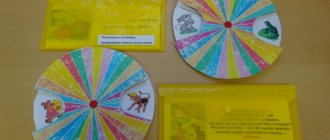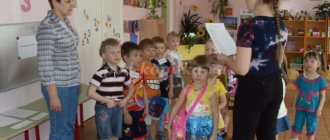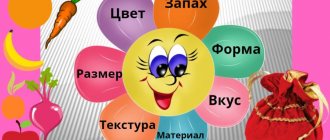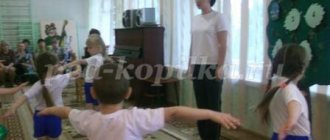Long-term work plan for the formation of life safety in the middle group in 2018-2019.
Long-term work plan for the formation
Life safety in the middle group 2018-2019
Educator:
Murygina A.V.
2018-2019
Safety
is not just the sum of acquired knowledge, but the ability to behave in various situations.
Long-term planning for the formation of safe behavior skills in children is carried out in accordance with the exemplary general educational program of preschool education “From birth to school” edited by N. E. Veraksa, T. S. Komarova, M. A. Vasilyeva, which assumes the content of children’s knowledge and skills in the following sections:
- — safe behavior in nature;
- — road safety;
- — safety of one’s own life;
Goals:
- Familiarizing children with the basic principles of safe behavior in various life situations: in everyday life, in society, in nature.
- Develop the ability to independently apply them in life according to a given algorithm.
Tasks:
- To form the concept of “Fire” in children. Introduce children to the profession of firefighters. Pin
knowledge about the causes of fire and the rules of behavior when it occurs. Learn to dial the fire department telephone number, master the techniques of basic practical interaction with surrounding objects with which you can put out a fire. To instill in children self-confidence and the ability to navigate problem situations.
Develop caution and caution.
2) Classes on the topic “Dangerous objects and phenomena” will help cultivate the habit of safe
behavior and teach children to see moments of unjustified risk in everyday life. Instill the ability to competently handle objects around the child in the home environment. To acquaint children with various emergency situations, to develop psychological stability of behavior in dangerous and emergency situations. Develop a conscious, responsible and careful attitude towards your own safety and the safety of others. Develop the ability to independently use acquired knowledge and develop self-confidence.
- Take care of your health. To give children a general idea of health as a value that must be constantly taken care of. Teach children to take care of their health and the health of others, to form healthy lifestyle habits. Let children understand that many diseases do not arise out of nothing (they become infected), formulate rules that must be followed to protect themselves from infection. To familiarize yourself with the work of medical institutions, expand your understanding of different types of medicine.
4) Safe communication. Teach children to recognize situations that can be dangerous, develop the skills of correct behavior in extreme situations that threaten life and health, the ability to consciously avoid and even prevent them, develop the ability to find a constructive way out of the current situation, make a decision and react accordingly. Develop the ability to independently use acquired knowledge and develop self-confidence.
5) Introducing children to traffic rules, the responsibilities of pedestrians and road signs. Knowledge of the meaning of a traffic light on the road and all its colors separately. Know and follow traffic rules. Expand knowledge about the rules of behavior for children on the streets and roads. To consolidate the idea of the place of crossing the roadway at the zebra crossing. Rules of behavior on the roads during seasonal weather changes.
Work plan for the year
| Month | A week | The content of the work | Practical solution | |
| Games, entertainment, etc. | Fiction | |||
| September | 1 Week | Topic: “Svetik - tricolor.” Goal: to introduce children to traffic lights and the purpose of each color. Identify information children have about traffic lights. | D\i “Find the right traffic light.” Goal: to develop attention and thinking. | Looking at pictures of traffic lights. Goal: to consolidate knowledge about traffic lights. |
| 2 week | Topic: "Getting to know the street." Goal: to supplement children’s ideas about the street with new information: the houses on it have different purposes, people live in some of them. In others there are institutions - shops, a school, a post office. Cars are moving along the roadway. | Walk “Getting to know the street”. Purpose: to give a general idea of the meaning of the word street. P\i "traffic rules". Goal: develop motor activity, reinforce traffic rules. | Looking at an album of the streets of our city. | |
| 3 week | Topic: “Pinocchio goes to the circus” (game exercise). Goal: to teach children to behave correctly in public transport. | S/r game "Trolleybus" Goal: To enrich the gaming experience by combining individual actions into a single storyline; develop interest and desire to participate in the game. | A fairy tale about: “a naughty bunny and bear cubs” Reading the poem “My Street” by S. Mikhalkov. | |
| 4 week | Topic: "Dangerous objects." Goal: To clarify children’s ideas about sources of danger at home and about the rules for using household appliances. | D/i “Find pictures” Goal: To teach children to find dangerous objects in the picture. | Looking at illustrations. Goal: to conduct a conversation about the sources of danger at home, about the rules for using household appliances. | |
| October | 1 Week | Topic: “One, two, three, what can be dangerous - find it.” Goal: to consolidate an understanding of the sources of danger at home, on the street, and about the rules for using household appliances. | D/i “One, two, three, find what could be dangerous.” Goal: to consolidate knowledge about sources of danger at home and on the street. | |
| 2 week | Topic: “Attention road.” Goal: to give children an idea of how to properly exit public transport, enter the front door and exit the back door. | Walk “Who are pedestrians?” Purpose: to give an idea of underground and overland passages; consolidate knowledge of how to cross the street correctly. D/i: “Street” Goal: Learn to name parts of the street (road, sidewalk, houses, traffic lights, pedestrian crossing). | Reading the book “Road Rules”, V. Kozhevnikova, A. Severny. "Traffic light". Examination of the series of pictures “Our Street”. | |
| 3 week | Topic: “Fire is a friend. Fire is the enemy." Goal: To expand children's knowledge about the rules of safe behavior with fire; introduce children to the firefighter uniform. | P/i "Fire in the hearth." Goals: to develop reaction speed, dexterity, spatial orientation, attention, endurance; to form a sense of courage, discipline, will and desire to win, as well as a culture of behavior in everyday life. | Looking at illustrations depicting a firefighter uniform and looking at illustrations on the topic "Fire" Goal: to consolidate knowledge about the causes of fire and its consequences. | |
| 4 week | Topic: “How to keep your skin healthy?” Goal: Expand children's understanding of the protective properties of skin and skin care skills. | D/i “A doll came to visit us.” Goal: develop hygiene skills. D/i "Good - bad." | ||
| November | 1 Week | Topic: “Every citizen knows this number – 101”! Purpose: To familiarize children with fire safety rules; form an idea of behavior in the event of a fire threat; cultivate a sympathetic attitude towards the victim. | Di “What burns, what doesn’t burn” - introduce flammable and non-flammable materials P/i "After the fire" Goal: to develop the ability to wind a cord onto a reel. | Reading the work "Cat's House." Goal: to clarify how the heroes managed to put out the fire. |
| 2 week | Topic: “Svetik - tricolor” - according to a traffic light signal. Goal: to consolidate existing ideas about a traffic light, its purpose and principle of operation; develop interest in traffic rules; introduce children to the work of a traffic controller on the street. | S/r game “City Trip”. Goal: teaching children to implement a game plan to create transport from a large builder, to learn how to play with the construction. | "Three-eyed friend." Making riddles about traffic lights. Reading the poem by Y. Pishumov “Look, the guard is standing on our pavement.” Purpose: to introduce the author’s works. | |
| 3 week | Topic: “Travel to the country “My Health”. Goal: to clarify children’s knowledge of what parts the human body consists of, to talk about the role of the senses. | P/n “ | Looking at illustrations of a person. Purpose: to give an idea of the senses and why they are so important. | |
| 4 week | Topic: “Fire in the apartment.” Goal: to introduce children to the profession of a firefighter; form an idea of behavior in the event of a fire threat. | D/i: “1, 2, 3 – find what could be dangerous” Goal: to clarify children’s knowledge about sources of danger in the house, to develop intelligence and attention. | Reading S. Marshak “Fire”. Purpose: to introduce the author’s works. | |
| December | 1 Week | Topic: “Winter fun” (safety rules during winter games). Goal: To teach how to use a sled and play snowballs. | P/i “It’s snowing” Goal: to teach how to correlate your own actions with the actions of the participants in the game; exercise children in running, making turns around themselves. | Looking at the illustrations, the painting “Well, I went for a ride...”. Goal: to teach children to follow the rules while sledding and playing in the snow. |
| 2 week | Topic: “Personal safety at home.” Goal: Goal: continue to introduce children to the rules of behavior at home. | Table theater "The Wolf and the Seven Little Goats". Goal: To promote the emergence of games on the themes of Russian folk tales, to develop communication skills. | Reading poetry G. Shalaeva, O. Zhuravleva. "Don't open the door to strangers." | |
| 3 week | Topic: "Safety at home." Medicines and household chemicals. Purpose: To clarify children’s ideas about dangerous objects in everyday life that should not be played with. | D/i “Find your vitamin.” Goals: to teach orientation in space; distinguish the primary colors of the spectrum. | T. A. Shorygina “Remember, kids, pills are not candy” Goal: to develop children’s knowledge that they should not take medications without the permission of adults. | |
| 4 week | Topic: “Personal safety on the street.” (Not everyone you meet is a dear friend). Goal: to teach to see dangerous situations on the street, to introduce the rules of behavior with strangers. | D/i “Observer” (description of a person, signs, what he looks like). Goal: to develop attention, memory, logical thinking. | Reading the fairy tale “Little Red Riding Hood” by Charles Perrault. Purpose: to introduce the author’s works. | |
| January | 2 week | Topic: "Caution - Electrical Appliances." Goal: to teach how to use electrical appliances correctly. | D/i “Find pictures” Goal: To teach children to find dangerous objects in the picture. | Reading fiction: O. Bedarev “If”. Purpose: to introduce the author’s works. |
| 3 week | Topic: “Boulevard of Road Signs.” They don’t see it themselves, but point it out to others. Goal: Continue to familiarize children with road signs and their purpose; learn to remember signs; draw special attention of children to the zebra crossing pedestrian markings. | D/i “What sign is this?” D\i “Find out the sign, whether the sign was placed correctly.” Goal: consolidate knowledge about road signs. | Reading fiction by G. Yurmin “The Curious Mouse.” Goal: acquaintance with the author’s works. | |
| 4 week | "Heroic Professions" Goal: to introduce children to heroic professions: firefighters, rescuers. | S/r game “In the trampoline” Goal: To expand children’s understanding of the work of a doctor; develop the ability to correctly use the attributes of the game; develop children’s communication skills with adults and each other; enrich children's life experiences. | Reading S. Marshak “The Story of an Unknown Hero.” Goal: to continue to introduce the author’s works. | |
| February | 1 Week | Topic: “Hurry, don’t rush”! Purpose: to introduce children to some rules for the movement of pedestrians on the street, to give the concepts: pedestrian, ground, underground passage, roadway, sidewalk; teach children to pay attention to road signs; learn how to behave properly on the street. | Walk down the street. S/r game “You are a pedestrian today” Goal: to introduce children to a pedestrian crossing, to help them remember what it is for, and where it can be seen. | Reading fiction: S. Mikhalkov, “Walking carefully.” Purpose: to introduce the author’s works. |
| 2 week | Topic: “Riddles on fire safety rules.” Purpose: to clarify children’s knowledge about fire safety rules. | Verbal - game "Find the right solution." Goal: consolidate knowledge about fire safety | Reading poems on fire safety. Goal: teach children to follow fire safety rules. | |
| 3 week | Topic: “In the world of dangerous objects.” Purpose: to consolidate ideas about sharp objects, piercing and cutting objects, to warn against accidents in everyday life. | D/i “Find pictures” Goal: To teach children to find dangerous objects in the picture. | Reading a fairy tale by T. A. Sharygin. “Scissors and spools are not toys” Goal: to continue to introduce the author’s works. | |
| 4 week | Topic: “Travel to the country “My Health”, “How does my body work?” Purpose: to give initial ideas about the structure of the human body and the functions of its main organs. | D/i “Collect in your cart” Goal: to promote the formation of ideas about the benefits of natural products, the need to eat fresh fruits and vegetables, and to consolidate the classification of vegetables and fruits. | Review of the album "Man". Purpose: to give general ideas about a healthy lifestyle. | |
| March | 1 Week | Topic: “If there is no traffic light on the street.” Purpose: To familiarize children with the rules of crossing the road where there is no traffic light; establish rules of behavior for pedestrians on the street; continue to teach children to pay attention to road signs; cultivate a caring attitude towards everything that surrounds us: forest, buildings. | D/i “Did Dunno do the right thing.” Goal: to develop logical thinking, memory, imagination. | Memorizing S. Mikhalkov’s poem “Walking Carefully.” Goal: to continue to introduce the author’s works. |
| 2 week | Topic: "Ambulance" Purpose: to introduce children to the telephone number 103; teach how to call an ambulance; to form an idea of the profession of an emergency doctor, to cultivate respect for the work of an emergency doctor. | Simulation of game situations on the topic of first aid. Goal: to form an idea of the medical profession. | ||
| 3 week | Topic: “Fire Safety Quiz.” Goal: to clarify and consolidate children’s knowledge of fire safety rules. | S/r game “Young firefighters”. Goal: to form an understanding of the tools that firefighters use. | Examination of the painting “Firefighting”. Goal: to consolidate children’s knowledge about the causes of fire. | |
| 4 week | Topic: “Safety when communicating with animals.” Goal: familiarization with the rules of safe behavior with animals. | D/i: “Think and answer” Goal: To teach how to correctly answer questions about the rules of contact with animals. | Looking at the illustration "Pets". Goal: consolidate knowledge about domestic animals. | |
| April | 1 Week | Topic: “Modes of transport.” Goal: fixing types of urban transport, rules of behavior in it; give an idea of the characteristics of the movement of a trolleybus, bus, tram; the trolleybus moves using electricity; the bus is refueling with gasoline, the tram is moving on the rails. | D/i “Think and Say” (answers to questions) Goal: To teach how to correctly answer questions asked about the rules of behavior in transport. | Reading of S. Mikhalkov’s poem “Cyclist”. Goal: to continue to introduce the author’s works. |
| 2 week | Topic: “The kitchen is not a place for games.” Goal: to teach to notice dangerous objects in the kitchen: hot stove, cutting objects; explain to children why they should not play in the kitchen. | S/r game “Family. Cooking lunch" Goal: To develop children’s ability to translate life experience into a conventional game plan; promote the development of independent play of the child, the search for new gaming tasks and ways to solve them; develop creative and communication abilities. | Reading a story Yu. S. Vasilyuk. "In the kitchen" Goal: to consolidate children's knowledge about dangerous objects in the kitchen. | |
| 3 week | Topic: “Through the streets of our city.” Goal: to consolidate specific knowledge about the rules of behavior on the streets of the city and town; clarify knowledge of who regulates traffic on the streets; consolidate knowledge of road signs. | S/r game “City Trip”. Goal: teaching children to implement a game plan to create transport from a large builder, to learn how to play with the construction. | Looking at illustrations. Goal: to expand children’s knowledge about city streets, to teach them to identify roads, sidewalks, and houses. | |
| 4 week | Topic: “Microbes and viruses.” Goal: to teach children to take care of their health and avoid situations that are harmful to their health; cultivate the habit of observing personal hygiene rules. | The plot game “I will help myself, I will save my health.” Target: establish the rules of personal hygiene. | Reading a fairy tale by K.I. Chukovsky "Moidodyr" Purpose: to introduce the author’s works. | |
| May | 1 Week | Topic: “Introduction to some rules for the movement of pedestrians on the street.” Goal: to introduce children to some rules for pedestrians, to the concepts: pedestrian, ground crossing, underground crossing. | D/i “Guess the sign” Goal: To teach children to find and show the “Pedestrian crossing” sign among other unfamiliar signs. | Looking at illustrations. Goal: to expand children’s knowledge about city streets, to teach them to identify roads, sidewalks, and houses. |
| 2 week | Topic: "If you are lost." Goal: to bring children to the understanding that for help they need to turn not to any adult, but to a policeman, a seller, or a military man; Help children understand the importance of knowing their address and telephone number. | Dramatization game (sketch) r.n. fairy tales "The cat, the rooster and the fox" Goal: To promote the emergence of games on the themes of Russian folk tales, to develop communication skills. | Funny story M. Manakova. "Someone else's yard" Goal: tell children how the hero of the story got lost in someone else's yard. | |
| 3 week | Topic: “Sunstroke” Goal: to teach children the rules of behavior in the hot summer. | S/r game “Walk in the forest” Goal: To develop interest and desire to participate in the game; enrich children's gaming experience; to form the ability to form emotional contact with comrades; stimulate children's creative activity in play. | Looking at illustrations about the rules of behavior in the hot season. Purpose: to give a general idea of how to behave in hot weather. | |
| 4 week | Topic: “Sun, air and water are our best friends!” Target: familiarization with the rules of behavior and safety near bodies of water and in the park. | P/n “ | Reading a fairy tale T. Yufereva. "Rain and Sun" Goal: to consolidate children's knowledge about the benefits of sun and rain in nature. | |
MAGAZINE Preschooler.RF
Summary of a lesson on life safety in the middle group “Beware of ice”teacher Vakhitova N.A. G. Yugorsk 2021 MADOU “general developmental kindergarten “Guselki”
Program content:
- Give children an idea of ice as a natural phenomenon.
- Introduce children to the concepts of “slippery road” and the peculiarities of transport on it; with a slippery road .
- To instill in children a conscious attitude towards compliance with traffic safety rules.
Vocabulary work: ice.
Methodological techniques: artistic expression, conversation, questions of a cause-and-effect nature, creating a problem situation, conducting an experiment.
Preliminary work: excursion to the road, observing its changes depending on weather conditions; conversations about traffic rules, reading the poem “Ice” by I. Leshkevich.
Progress of the lesson.
Educator.
-Guys, we live in the beautiful city of Yugorsk. Our city is especially beautiful in winter: there is a lot of snow all around, the trees are covered with silvery frost. Cars move along the wide snow-covered streets, buses drive, pedestrians walk along the sidewalk, and no one bothers anyone, because everyone follows the traffic rules.
Didactic game "Good-bad" .
-Guys, tell me good and bad - “winter” (good - a lot of snow, children make snow buildings; bad - traffic jams, drifts on the roads)
“Ice is good” (skating, playing hockey, winter fishing, ice for ice cream in the summer; bad – accidents on the roads, people falling).
(The teacher displays several pictures)
- Guys, what do these pictures have in common? (they depict road accidents).
-What do you think caused the accident? (children's answers).
-What is ice? Why does ice form? (children's answers)
Reading the poem "Ice"
It's frozen in the morning, there's no warmth from yesterday, there's ice on the roads, and everything is carrying cars.
The sidewalks are like a skating rink, I could take another step, but the soles let me down, they are very slippery.
How much trouble there is from ice! There is a job for the janitors - to pour salt and sand so that pedestrians can pass.
Educator: Winter is the most dangerous period for drivers and pedestrians. Why guys? (the number of accidents increases; if there is wind outside, the temperature is zero, ice appears on the roads; cars on a slippery road are much more difficult to brake than on dry asphalt)
-Guys, many of you have traveled with your dad by car more than once. How should dad drive the car to avoid skidding on the road? (move at a low speed, keep a distance between cars, avoid sharp braking when turning, turn the steering wheel smoothly, drive with headlights on).
Physical exercise.
It's snowing, it's snowing The janitor is sweeping the street, The janitor is sweeping the street, People are walking on the side.
Educator: Pedestrians in icy conditions should also be attentive and careful. When going outside, pay attention to your shoes: the soles should not be slippery)
-How should you move along the road? (you need to look at your feet, try to avoid dangerous places; in icy conditions you need to move like a skier with small sliding steps, since your legs move apart and if you lose your balance, a bruise, dislocation or fracture is guaranteed; to maintain balance, your hands must be free, do not keep them in your pockets).
Well, if a fall occurs, what should you do? crossing the road in front of nearby traffic is dangerous.
Reading a poem
There is ice on the road. Stop! Attention people! Dear pedestrians, Place your feet carefully!
And it is especially dangerous if there is transport nearby. A speeding car cannot brake quickly.
On ice the wheels are not obedient. You need to know and remember this. Attention and caution. They will help you in case of ice.
-How do road services help in icy conditions? (they clean the roads, sprinkle sand on slippery roads.
Educator: Today we got acquainted with the road sign “Slippery road” , and to better remember this sign, draw it on a piece of paper.
Children draw on their own.
| Next > |





